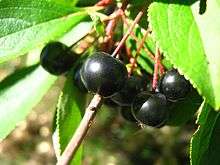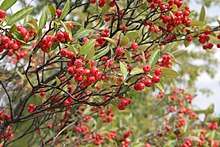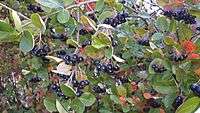Aronia
Aronia is a genus of deciduous shrubs, the chokeberries, in the family Rosaceae native to eastern North America and most commonly found in wet woods and swamps.[2][3][4] The genus is usually considered to contain two[5] or three[4][6] species, one of which is naturalized in Europe.[7] A fourth form that has long been cultivated under the name Aronia[6] is now considered to be an intergeneric hybrid, Sorbaronia mitschurinii.
| Aronia | |
|---|---|
 | |
| Aronia berries | |
| Scientific classification | |
| Kingdom: | Plantae |
| Clade: | Tracheophytes |
| Clade: | Angiosperms |
| Clade: | Eudicots |
| Clade: | Rosids |
| Order: | Rosales |
| Family: | Rosaceae |
| Subfamily: | Amygdaloideae |
| Tribe: | Maleae |
| Subtribe: | Malinae |
| Genus: | Aronia Medik. 1789, conserved name not J. Mitch. 1769 nor Mitch. 1748 |
| Species | |
| |
| Synonyms[1] | |
| |
Chokeberries are cultivated as ornamental plants and as food products. The sour berries, or aronia berries, can be eaten raw off the bush, but are more frequently processed. They can be found in wine, jam, syrup, juice, soft spreads, tea, salsa, chili starters, extracts, beer, ice cream, gummies and tinctures.[8] The name "chokeberry" comes from the astringency of the fruits, which create the sensation of making one's mouth pucker.[8]
Chokeberries are often mistakenly called chokecherries, the common name for Prunus virginiana. Further adding to the ambiguity, a variety of Prunus virginiana is melanocarpa,[9] and readily confused with black chokeberry because it is commonly referred to as "black chokeberry" or "aronia". Aronia berries and chokecherries both contain polyphenolic compounds, such as anthocyanins, yet the two plants are distantly related within the family Rosaceae.
Identification and taxonomy
The leaves are alternate, simple, and oblanceolate with crenate margins and pinnate venation; in autumn the leaves turn a bold red color. Dark trichomes are present on the upper midrib surface. The flowers are small, with 5 petals and 5 sepals, and produced in corymbs of 10–25 together. Hypanthium is urn-shaped. The fruit is a small pome, with an astringent flavor.
Aronia has been thought to be closely related to Photinia, and has been included in that genus in some classifications,[10] but botanist Cornelis Kalkman observed that a combined genus should be under the older name Aronia.[11] The combined genus contains about 65 species.[12] In 2004, Kalkman expressed doubt about the monophyly of the combined group, and new molecular studies confirm this.[13][14] They do not place these two genera together or even near one another.
In eastern North America are two well-known species, named after their fruit color, red chokeberry and black chokeberry, plus a purple chokeberry whose origin is a natural hybrid of the two.[12] A fourth species, Aronia mitschurinii, that apparently originated in cultivation, is also known as Sorbaronia mitschurinii.[15]
| Flowers | Fruit | Scientific name | Common name | Description | Distribution |
|---|---|---|---|---|---|
 |  | Aronia arbutifolia (Photinia pyrifolia) | Red chokeberry | grows to 2–4m (6.5-13ft) tall, rarely up to 6 m (19.6ft) and 1–2 m (3-6.5ft) wide. Leaves are 5–8 cm wide and densely pubescent on the underside. The flowers are white or pale pink, 1 cm wide, with glandular sepals. The fruit is red, 4–10 mm wide, persisting into winter. | Eastern Canada and to the eastern and central United States, from eastern Texas to Nova Scotia inland to Ontario, Ohio, Kentucky, and Oklahoma |
.jpg) | Aronia melanocarpa (Photinia melanocarpa),[2] | Black chokeberry | tends to be smaller, rarely exceeding 1 m (3ft) tall and 3 m (9.8ft) wide, and spreads readily by root sprouts. The leaves are smaller, not more than 6-cm wide, with terminal glands on leaf teeth and a glabrous underside. The flowers are white, 1.5 cm wide, with glabrous sepals. The fruit is black, 6–9 mm wide, not persisting into winter. | Eastern North America, ranging from Canada to the central United States, from Newfoundland west to Ontario and Minnesota, south as far as Arkansas, Alabama, and Georgia | |
 | Aronia prunifolia (Photinia floribunda)[3] | Purple chokeberry | apparently originated as a hybrid of the black and red chokeberries but might be more accurately considered a distinct species than a hybrid[12] (see also nothospecies). Leaves are moderately pubescent on the underside. Few to no glands are present on the sepal surface. The fruit is dark purple to black, 7–10 mm in width, not persisting into winter. There are purple chokeberry populations which seem to be self-sustaining independent of the two parent species – including an introduced one in northern Germany where neither parent species occurs – leading botanist Alan Weakley to consider it a full species rather than a hybrid.[12] The range of the purple chokeberry is roughly that of the black chokeberry; it is found in areas (such as Michigan and Missouri) where the red chokeberry is not.[16] | Eastern Canada and to the eastern and central United States, from Nova Scotia west to Ontario and Wisconsin, south as far as western South Carolina with an isolated population reported in southern Alabama | |
- Aronia flowers and leaves (Aronia melanocarpa)
 Purple chokeberry (Aronia prunifolia)
Purple chokeberry (Aronia prunifolia) Red chokeberry (Aronia arbutifolia)
Red chokeberry (Aronia arbutifolia)
Cultivation
Aronia is considered cold hardy and heat tolerant in USDA Zones 3 to 8.[17][18] Aronia plants grow well both in orchard-type rows or set as landscape elements, including several varieties in 3 to 12 foot heights.[17]
Products and uses
The chokeberries are attractive ornamental plants for gardens. They are naturally understory and woodland edge plants, and grow well when planted under trees. Chokeberries are resistant to drought, insects, pollution, and disease. A number of cultivars, including A. arbutifolia 'Brilliant' and A. melanocarpa 'Autumn magic', have been selected for their striking fall leaf color.
An aronia wine is made in Lithuania. In Poland, aronia berries are added to jams and juices or dried to make a herbal tea sometimes blended with other ingredients, such as blackcurrant.[19] In Bosnia and Herzegovina, the berries are sold fresh and frozen or made into juices, jams and teas.[20] Aronia is also used as a flavoring or colorant for beverages or yogurts.[19] Juice from the ripe berries is astringent, semi-sweet (moderate sugar content), sour (low pH), and contains a low level of vitamin C.[21] The berries have a tart flavor and, in addition to juice, can be baked into breads.[19] In the United States and Canada, aronia juice concentrate is used in manufactured juice blends.
Polyphenol content
Aronia melanocarpa (black chokeberry) has attracted scientific interest due to its deep purple, almost black pigmentation that arises from dense contents of polyphenols, especially anthocyanins. Total polyphenol content is 1752 mg per 100 g dry weight,[22] anthocyanin content is 1480 mg per 100 g dry weight, and proanthocyanidin concentration is 664 mg per 100 g fresh weight.[23][24] These values are among the highest measured in plants to date. The black aronia species contains higher levels of anthocyanins than purple (Aronia prunifolia) or red aronia (Aronia arbutifolia), whereas red and purple aronia are richer in phenolic acid and proanthocyanins.[25]
The plant produces these pigments mainly in the leaves and skin of the berries to protect the pulp and seeds from constant exposure to ultraviolet radiation and production of free radicals.[26][27][28] By absorbing UV rays in the blue-purple spectrum, leaf and skin pigments filter intense sunlight, serve antioxidant functions and thereby have a role assuring regeneration of the species. Brightly colorful pigmentation also attracts birds and other animals to consume the fruit and disperse the seeds in their droppings.[26][29]
Analysis of polyphenols in chokeberries has identified the following individual chemicals (among hundreds known to exist in the plant kingdom): cyanidin-3-galactoside, cyanidin-3-arabinoside, quercetin-3-glycoside, epicatechin, caffeic acid, delphinidin, petunidin, pelargonidin, peonidin, and malvidin.[23][25][30] All these except caffeic acid are members of the flavonoid category of phenolics.
For reference to phenolics, flavonoids, anthocyanins, and similar plant-derived phytochemicals,[22] Wikipedia has a list of phytochemicals and foods in which they are prominent.
References
- Pankhurst, Richard J. (2014). "Aronia". In Flora of North America Editorial Committee (ed.). Flora of North America North of Mexico (FNA). 9. New York and Oxford – via eFloras.org, Missouri Botanical Garden, St. Louis, MO & Harvard University Herbaria, Cambridge, MA.
- "Photinia melanocarpa". Natural Resources Conservation Service PLANTS Database. USDA.
- "Photinia floribunda". Natural Resources Conservation Service PLANTS Database. USDA.
- Reznicek, A. A.; Voss, E. G.; Walters, B. S., eds. (February 2011). "Aronia". Michigan Flora Online. University of Michigan Herbarium.
- Mark Brand (2010). "Aronia: Native Shrubs With Untapped Potential" (PDF). Arnoldia. 67 (3): 14–25.
- "USDA GRIN entry for Aronia". Archived from the original on 2015-09-24. Retrieved 2017-12-16.
- "Aronia × prunifolia". Germplasm Resources Information Network (GRIN). Agricultural Research Service (ARS), United States Department of Agriculture (USDA). Retrieved 15 December 2017.
- Everhart, Eldon (March 4, 2009). "Aronia - A New Crop for Iowa". Retrieved May 24, 2013.
- "Prunus virginiana var. melanocarpa". Natural Resources Conservation Service PLANTS Database. USDA.
- Robertson, K. R.; Phipps, J. B.; Rohrer, J. R.; Smith, P. G. (1991). "A synopsis of genera in Maloideae (Rosaceae)". Systematic Botany. 16 (2): 376–394. doi:10.2307/2419287. JSTOR 2419287.
- Kalkman, C. (2004). "Rosaceae". In Kubitzki, K. (ed.). Flowering Plants. Dicotyledons: Celastrales, Oxalidales, Rosales, Cornales, Ericales. The families and genera of vascular plants. Berlin: Springer. p. 377. ISBN 978-3-540-06512-8.
- Alan S. Weakley (April 2008). "Flora of the Carolinas, Virginia, and Georgia, and Surrounding Areas".
- Potter, D.; Eriksson, T.; Evans, R. C.; Oh, S.; Smedmark, J. E. E.; Morgan, D. R.; Kerr, M.; Robertson, K. R.; Arsenault, M.; Dickinson, T. A.; Campbell, C. S. (2007). "Phylogeny and classification of Rosaceae". Plant Systematics and Evolution. 266 (1–2): 5–43. doi:10.1007/s00606-007-0539-9. [Referring to the subfamily by the name "Spiraeoideae"]
- Campbell C. S.; R. C. Evans; D. R. Morgan; T. A. Dickinson & M. P. Arsenault (2007). "Phylogeny of subtribe Pyrinae (formerly the Maloideae, Rosaceae): Limited resolution of a complex evolutionary history". Pl. Syst. Evol. 266 (1–2): 119–145. CiteSeerX 10.1.1.453.8954. doi:10.1007/s00606-007-0545-y.
- Sennikov, A.N.; Phipps, J.B. (2013). "Atlas Florae Europaeae notes, 19 – 22. Nomenclatural changes and taxonomic adjustments in some native and introduced species of Malinae (Rosaceae) in Europe". Willdenowia - Annals of the Botanic Garden and Botanical Museum Berlin-Dahlem. 43 (1): 33–44. doi:10.3372/wi.43.43104.
- James W. Hardin (May–Jun 1973). "The Enigmatic Chokeberries (Aronia, Rosaceae)". Bulletin of the Torrey Botanical Club. 100 (3): 178–184. doi:10.2307/2484630. JSTOR 2484630.
- "Black chokeberry" (PDF). US Department of Agriculture. May 2005. Retrieved 1 December 2015.
- "Aronia melanocarpa". Missouri Botanical Garden. 2015. Retrieved 1 December 2015.
- Steven A. McKay (March 17, 2004). "Demand increasing for aronia and elderberry in North America" (PDF). New York Berry News. 3 (11). Archived from the original (PDF) on March 13, 2009.
- "Aronia berries, from Bosnia to Berlin". January 31, 2015.
- Skupien K, Oszmianski J (2007). "The effect of mineral fertilization on nutritive value and biological activity of chokeberry fruit" (PDF). Agric Food Sci. 16: 46–55. doi:10.2137/145960607781635822. Retrieved 7 March 2014.
- "Total polyphenols in black chokeberry". Phenol-Explorer. 2014. Retrieved 27 March 2014.
- Wu X, Gu L, Prior RL, McKay S (2004). "Characterization of anthocyanins and proanthocyanidins in some cultivars of Ribes, Aronia and Sambucus and their antioxidant capacity". Journal of Agricultural and Food Chemistry. 52 (26): 7846–56. doi:10.1021/jf0486850. PMID 15612766.
- Wu X; et al. (2006). "Concentrations of anthocyanins in common foods in the United States and estimation of normal consumption". Journal of Agricultural and Food Chemistry. 54 (1): 4069–75. doi:10.1021/jf060300l. PMID 16719536.
- Taheri, R; Connolly, B. A.; Brand, M. H.; Bolling, B. W. (2013). "Underutilized chokeberry (Aronia melanocarpa, Aronia arbutifolia, Aronia prunifolia) accessions are rich sources of anthocyanins, flavonoids, hydroxycinnamic acids, and proanthocyanidins". Journal of Agricultural and Food Chemistry. 61 (36): 8581–8. doi:10.1021/jf402449q. PMID 23941506.
- Simon PW (1996). "Plant pigments for color and nutrition". United States Department of Agriculture, University of Wisconsin. Retrieved 27 March 2014.
- Lee, J. E.; Kim, G. S.; Park, S; Kim, Y. H.; Kim, M. B.; Lee, W. S.; Jeong, S. W.; Lee, S. J.; Jin, J. S.; Shin, S. C. (2014). "Determination of chokeberry (Aronia melanocarpa) polyphenol components using liquid chromatography-tandem mass spectrometry: Overall contribution to antioxidant activity". Food Chemistry. 146: 1–5. doi:10.1016/j.foodchem.2013.09.029. PMID 24176305.
- Ipatova, O. M.; Prozorovskaia, N. N.; Rusina, I. F.; Prozorovskiĭ, V. N. (2003). "Antioxidant properties of a leaf extract from Aronia (Aronia melanocarba) containing proanthocyanidins". Biomeditsinskaia Khimiia. 49 (2): 165–76. PMID 14565080.
- "Anthocyanins FAQ". MadSci Network. 2014. Retrieved 1 April 2014.
- Neveu V; et al. (2010). "Phenol-Explorer: an online comprehensive database on polyphenol contents in foods". Database. 2010: bap024. doi:10.1093/database/bap024. PMC 2860900. PMID 20428313. Retrieved 7 March 2014.
Further reading
- Aronia berries profile Report revised October 2013 by Joe M. Hannan, Iowa State University Extension and Outreach, Commercial Horticulture Field Specialist
External links
| Wikimedia Commons has media related to Aronia. |